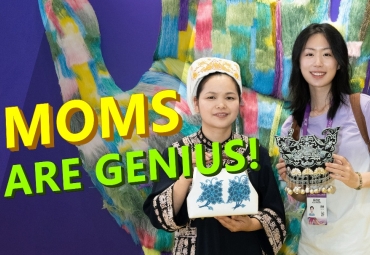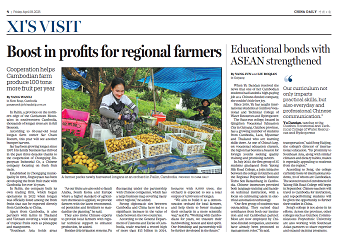Ancient craftsmanship brings modern life to rural residents
Sometimes urbanity stirs a sense of nostalgia for old tradition and technique, which endue handicrafts with a chance to revive and thrive.
This is just what rural residents in mountainous Guizhou, Southwest China, have witnessed.
OLD DYEING, MODERN CHOICE
Isatis root, an herb, has become a money-spinner in remote hilly areas in Guizhou. Its root and stem can be used as a medicine, while the fresh leaves can be made into dark blue plant dye called indigo, which local ethnic minorities have been using for generations to dye fabrics called batik.
Zhang Yiqiong has been making batik for 20 years. As the founder of a local batik company, Zhang has now hired more than 260 employees, and her business has helped over 2,800 local farmers shake off poverty.
"Making batik helps me make about 4,000 yuan ($565) a month, much higher than working in the field," said Wei Liyun, a batik technician in Miaolong village of Sandu, the only autonomous county of the Shui ethnic group in China.
"Batik had become part of my life, and we didn't stop doing it at home even during the epidemic," said Wei Liyun.
"The pattern of batik has unique ethnic characteristics, and we also incorporate modern aesthetic elements into our products. The materials are eco-friendly and very popular with customers," said Wu Huahui, a designer.
"Batik fabric is our main business now," said Zhang. "It adapts to the current consumption upgrading and rising ecological protection awareness. It's been better recognized and the demand is also increasing. Some large textile enterprises such as jeans manufacturers have come to us to seek cooperation. I believe it has big market potential."
DYING EMBROIDERY BACK TO LIFE
The Shui ethnic minority often raises horses to transport goods, which gave birth to a traditional skill -- horsetail embroidery.
Horsetail embroidery is a traditional embroidery style using horsehair and silk thread as the raw materials for the handicraft. The skill of weaving horsehair into thread and sewing traditional patterns have been passed down by Shui women for generations.
The art was listed as one of China's first intangible cultural heritages in 2006 and is called the "living fossil" for embroidery.
"In the past, horsetail embroidery was mainly used to stitch shoes, hats and bamboo baskets for newborn babies and the dresses for brides," said Wei Yingli, an inheritor of horsetail embroidery.
Wei Yingli said that for a long time, horsetail embroidery was unknown to the outside world. In addition, as the production process is complicated, time-consuming and laborious, the inheritance of the ancient technique once fell into a low ebb under the impact of machine embroidery.
With infrastructure improved and tourists flooding in, many marveled at the exquisite craftsmanship hidden deep in the mountains.
Wei Yingli initiated a horsetail embroidery association in Zhonghe township, which has now hired more than 900 experienced seamstresses. An average of over 300 horsetail embroideries are sold every month, bringing in more than 100,000 yuan.
"Our seamstresses also receive training to innovate in patterns and our embroideries are now used in clothes, bags, sheets and sofa covers," said Wei Yingli.
Stitching horsehair is not easy, even for an experienced seamstress. Sometimes a piece of complicated embroidery work can take over a year to finish. "So we mainly target the middle and high-end market," she said.
In 2013, Guizhou initiated a project to revive traditional artistry and so far the project has produced an output value of more than 6 billion yuan, benefiting over 500,000 women in the ethnic group areas. It has also been helpful to solve other social issues such as left-behind children and empty-nesters.
But the sudden hit of the coronavirus epidemic has cast a shadow over the burgeoning industry.
"We basically had no customers and tourists during the epidemic. So far, we have only received two orders this year, and I hope the epidemic will end and the flow of people, passengers and logistics will resume as soon as possible," said Wei Yingli.
The local government has earmarked a 4-million yuan fund to support the industry and help them sell products via livestreaming, trade fairs and the internet to tide over the difficulties.
All rights Reserved. 京ICP备13028878号-8







 Overview
Overview Guiyang
Guiyang Guian New Area
Guian New Area Liupanshui
Liupanshui Anshun
Anshun Qianxinan
Qianxinan Qiandongnan
Qiandongnan Qiannan
Qiannan Zunyi
Zunyi Tongren
Tongren Bijie
Bijie Guizhou commits to culture preservation and rural vitalization
Guizhou commits to culture preservation and rural vitalization Guizhou voice at 2025 national two sessions
Guizhou voice at 2025 national two sessions Meet the 'genius moms' at Shenzhen cultural fair
Meet the 'genius moms' at Shenzhen cultural fair 

